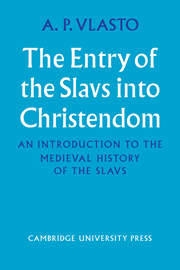Book contents
6 - THE BEGINNINGS OF MONASTICISM AMONG THE ORTHODOX SLAVS
Published online by Cambridge University Press: 23 November 2009
Summary
An Orthodox church is unthinkable without monastic institutions. While the Church calls upon us to live the life of a Christian according to our capacities the mere fact of living in the world imposes limitations on our spiritual achievements. Even a secular priest is concerned mainly with the sacramental aspect of religion, much less with the contemplative. The Church therefore recognises and gives full value to the many layers of human society, each with a different and necessary function, complementary to one another. Laymen, intermediate degrees and contemplatives all together make up the church. This is one aspect of the principle of ‘community’ (Russian sobornost), of each playing a part in a greater whole and in communion with the Holy Spirit each according to his lights. Thus without Marthas there can be no Marys. Our Lord Himself pronounced clearly on this: the Active life, being only a means, is of itself ineffective unless referred to the Contemplative. The life of Contemplation (θ∈ωρíα), which reunites the soul to God (vωσls Θ∈oû), is a witness by virtue of its mere being, not through knowing or doing. But what it knows by direct intellection it transmits to the world to be applied to its life of Action and to be embodied in its traditional forms. Thus Contemplation realises to the full Christ's First Commandment, active Christian life in the world—the Second. Each requires the support of the other.
- Type
- Chapter
- Information
- The Entry of the Slavs into ChristendomAn Introduction to the Medieval History of the Slavs, pp. 296 - 307Publisher: Cambridge University PressPrint publication year: 1970

